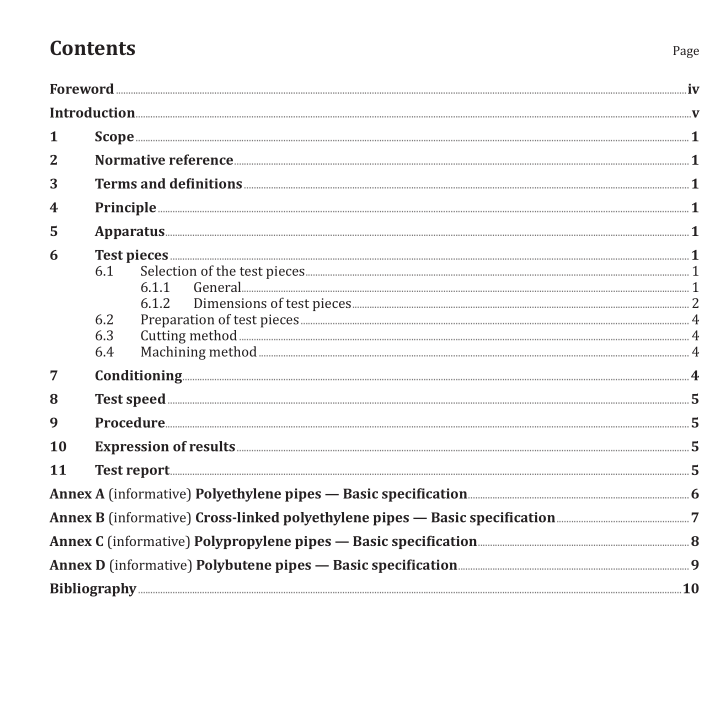ISO 6259-3:2015 pdf download.Thermoplastics pipes — Determination of tensile properties — Part 3: Polyolefin pipes
This part of ISO 6259 specifies a method of determining the tensile properties of polyolefin (polyethylene,cross-linked polyethylene, polypropylene, and polybutene) pipes, and the following properties:
— the stress at yield;
— the elongation at break.
This part of ISO 6259 also gives the corresponding basic specifications in Annexes A to D for information purposes only.
2 Normative reference
The following documents, in whole or in part, are normatively referenced in this document and are indispensable for its application. For dated references, only the edition cited applies. For undated references, the latest edition of the referenced document (including any amendments) applies.
ISO 527-1:2012, Plastics — Determination of tensile properties — Part 1: General principles
ISO 6259-1:2015, Thermoplastics pipes — Determination of tensile properties — Part 1: General test method
3 Terms and definitions
For the purposes of this document, the terms and definitions given in ISO 6259-1 apply.
4 Principle
See ISO 6259-1:2015, Clause 4, applicable to thermoplastics materials covered by this part of ISO 6259.
5 Apparatus
See ISO 6259-1:2015, Clause 5, applicable to thermoplastics materials covered by this part of ISO 6259.
6 Test pieces
6.1 Selection of the test pieces
6.1.1 General
The test pieces shall be obtained by die cutting or machining.
NOTE 1 When the thickness of the pipe is less than or equal to 12 mm, the test pieces are to be die cut preferably.
When the thickness of the pipes is greater than 12 mm the test pieces are to be machined preferably.
NOTE 2 Care ought to be taken when using die cutting to avoid damaging the test specimen or producing non parallel sides.
6.1.2 Dimensions of test pieces
Test pieces shall be either of Type 1, the shape and dimensions of which are given in Figure 1 and Table 1,Type 2, the shape and dimensions of which are given in Figure 2 and Table 2, or Type 3, the shape and dimensions of which are given in Figure 3 and Table 3. The choice of test piece is dependent on the wall thickness of the pipe from which it is taken (see 6.2).
NOTE 1 The Type 1 test piece is identical to the Type 1B specified in ISO 527-2 [1] . The Type 2 test piece is identical to the Type 2 specified in ISO 6259-2 [2] . The Type 3 test piece is identical to the Type B test piece in ISO 13953 [3] .
NOTE 2 In order to avoid slippage in the grips, it is recommended that the width of the ends of the test piece (B) be increased in proportion to the thickness (e n ) in accordance with Formula (1):
B = e n + 15 (mm)
6.2 Preparation of test pieces
The test pieces shall be taken from the centre of strips cut from the length of pipe in accordance with ISO 6259-1:2015, 6.2.1. The type of test piece shall be selected according to the thickness of the pipe as shown in Table 4.
.3 Cutting method
Use a cutting die with a profile corresponding to that of the Type 1 or Type 2 test piece, depending on thickness of the pipe, see ISO 6259-1:2015, 5.6.
Cut out the test piece at ambient temperature, applying the die cutter to the inner surface of the strip and exerting a continuous uniform pressure.
6.4 Machining method
See ISO 6259-1:2015, 6.2.2.3.
7 Conditioning
See ISO 6259-1:2015, Clause 7.
8 Test speed
The test speed, i.e. the speed of separation of the grips, shall depend on the thickness of the pipes, as specified in Table 5. The tolerance on test speed is in accordance with ISO 527-1:2012, Table 1.
If other speeds are used, the correlation between these and the specified speed shall be shown. The speed specified shall be used in cases of dispute.
9 Procedure
See ISO 6259-1:2015, Clause 9.
NOTE If there is a specified requirement for elongation of the test pieces, the test can be stopped when this requirement is exceeded.
10 Expression of results
See ISO 6259-1:2015, Clause 10.
11 Test report
See ISO 6259-1:2015, Clause 11.ISO 6259-3 pdf download.ISO 6259-3 pdf download
